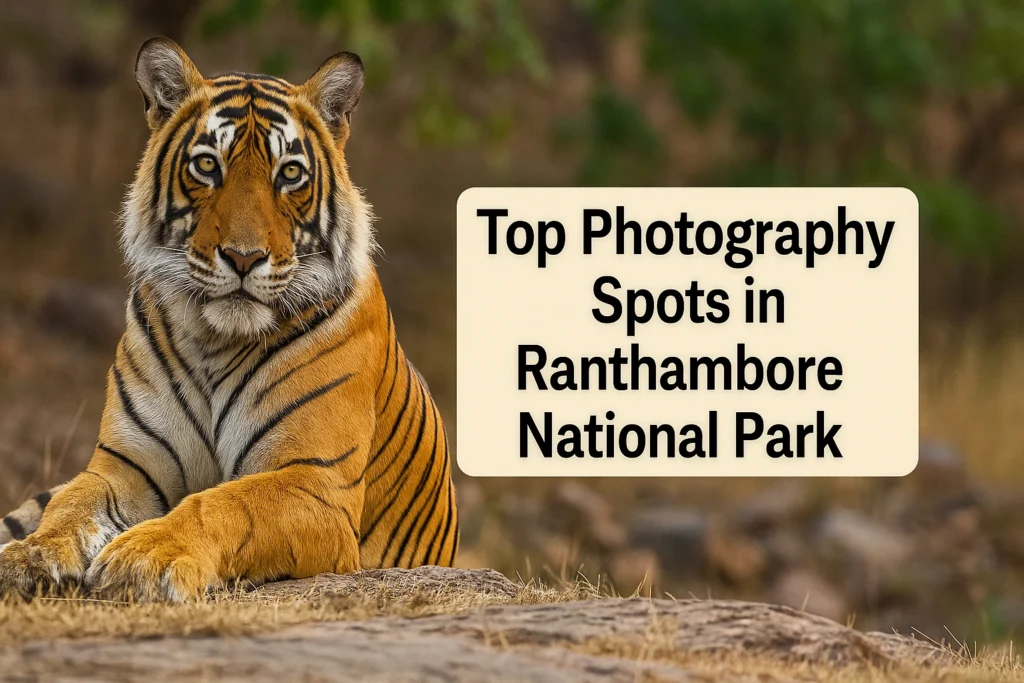
Table of Contents
Ranthambore National Park is a dream destination for photographers. While it’s famous for its tigers, the park also offers a rich canvas of landscapes, ancient ruins, and rare wildlife species. Whether you’re a seasoned wildlife photographer or a nature-loving traveler, Ranthambore gives you countless opportunities to capture unforgettable shots. In this blog, we’ll walk you through the best photography spots inside the park, along with tips to help you make the most of your safari.
1. Zone 3 – Padam Talao and Rajbagh Ruins
Zone 3 is one of the most photogenic zones in Ranthambore. The serene Padam Talao, often surrounded by deer and crocodiles, creates perfect reflection shots, especially during the early morning hours. Just nearby, the Rajbagh ruins—remnants of old palaces and arches—add a dramatic touch to any wildlife photo, especially if a tiger happens to be resting there.
Photography Tip: Early morning safaris offer soft light and better chances of spotting wildlife in action.
Read our Blog :- Top Mistakes to Avoid on a Ranthambore Safari
2. Ranthambore Fort – Panoramic Jungle Views
Inside the park itself, Ranthambore Fort offers sweeping views of the forest and nearby lakes. The fort’s aged stone structures, arches, and temples provide a unique blend of historical and natural elements in your photos.
Photography Tip: Carry a wide-angle lens to capture both the structure and the landscape. Sunset shots from the fort are particularly rewarding.
3. Malik Talao – Reflections and Birdlife
Malik Talao is a smaller lake but a haven for bird photographers. Painted storks, herons, and even crocodiles frequent the area, offering excellent opportunities for wildlife and nature shots. The still waters create perfect mirror-like reflections during the early hours of the day.
Photography Tip: A zoom lens is ideal here, especially for bird photography. Shoot from low angles for a more dramatic frame.
Discover Our New Blog :- Best Time to Visit Ranthambore
4. Kachida Valley – Home of the Sloth Bear and Leopard
Located in Zone 5, Kachida Valley is known for its hilly terrain and sightings of elusive animals like leopards, sloth bears, and hyenas. The uneven land and scattered boulders create a natural setting perfect for action shots of wildlife in motion.
Photography Tip: Be patient. Use burst mode and keep a telephoto lens handy to capture movement from a safe distance.
5. Bakola Region – Perfect for Light and Shadow Play
Bakola is often appreciated for its natural beauty and the way light filters through the forest canopy. This area is ideal for moody, artistic wildlife photography where the jungle atmosphere becomes part of the subject.
Photography Tip: Use a fast shutter speed with a lower ISO to avoid blur and grain. This spot is ideal during morning safaris.
6. Lakkarda – Ideal for Tracking and Storytelling Shots
Lakkarda in Zone 2 is well known for frequent sightings of tiger pugmarks and resting spots. The dry grasslands contrasting with the forested backdrops make it an excellent place to shoot storytelling images of the tiger’s journey.
Photography Tip: Look for fresh pugmarks and set your focus manually. Framing the trails with the background helps add depth to the shot.
7. Surwal Lake – A Hidden Gem Outside the Park
Located around 25 km from the park, Surwal Lake is ideal for sunrise and bird photography. During winter, it attracts migratory birds like flamingos and pelicans. The soft early morning light makes it a peaceful yet stunning place for landscape photographers.
Photography Tip: Use a tripod for long-exposure sunrise shots. Keep a telephoto lens for distant bird photography.
Photography Tips for Your Ranthambore Trip
Use silent shutter mode to avoid disturbing wildlife
Carry extra batteries and memory cards
Dress in neutral colors to blend into the surroundings
Never use flash during safari photography
A bean bag or monopod helps keep your camera stable in safari vehicles
Travel Smart: Hire a Taxi for a Comfortable Photography Tour
Exploring Ranthambore’s best photography spots becomes much easier with a reliable taxi service. Whether you’re arriving from Jaipur, Delhi, or Kota, a local
Ranthambore taxi services can help you reach the park on time for morning safaris, cover nearby lakes and forts, and carry your gear safely. Choosing a driver familiar with the region ensures you never miss the best light or hidden spots.
Final Thoughts
Ranthambore is more than a tiger reserve—it’s a landscape rich in drama, history, and beauty. Whether you’re focusing on wildlife, landscapes, or heritage architecture, the park offers endless photo opportunities. Plan your routes wisely, stay patient during safaris, and trust your eye to capture the untamed spirit of Rajasthan.
